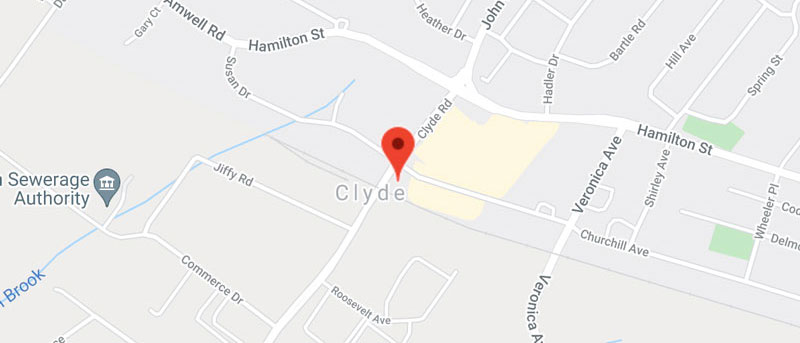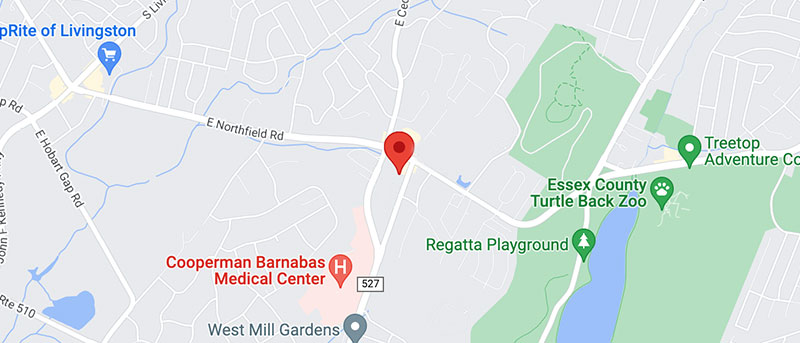Eyelid bag surgery in New Jersey, also known as lower eyelid surgery, is a procedure wherein excess sagging skin is removed from the lower eyelids. The surgeon makes strategic incisions within the lower eyelid to remove unwanted skin tissues and excess fat, thereby tightening and smoothing the lower eyelids. The surgery may also include techniques to fill in hollows and facilitate a smooth transition from the lower eyelids to the cheeks. Each surgery is individually curated according to your unique goals and requirements.
Are you tired of seeing bags under your eyelids?
How Can Eyelid Bag Surgery Help?

Dr. Ramesh speaking about eyelid bag surgery at the Cosmetic Surgery Forum.
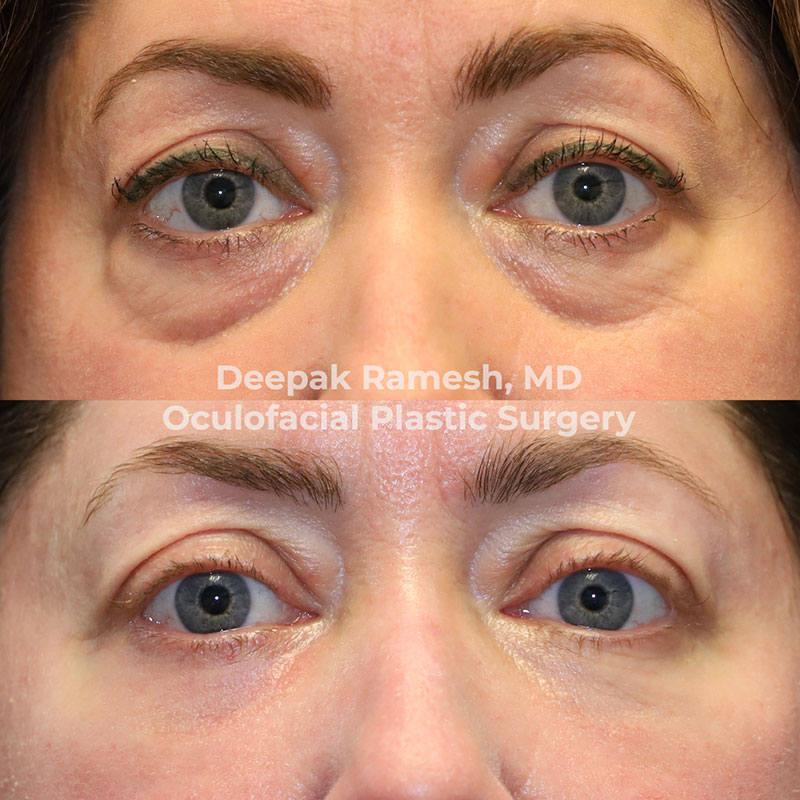
What Complaints Can Be Treated?
- Eyelid Bags
- Dark Circles
- Puffy Eyes
- Heavy Eyelids
- Tired Eyes
What Causes Eyelid Bags?
Eyelid bags can be caused by extra skin, herniated fat pads, hollowness and shadowing, or pigment in the skin. Dr. Ramesh’s latest research paper on treatment of eyelid bags discusses the underlying causes and best treatments for these.
Herniated Fat
The lower eyelid is full of fat that normally surrounds the eyeball and acts as a “shock absorber”. As people age, the tissues that hold this fat behind the eyeball stretch out, allowing this fat to descend downwards and appear as a “bag”. This can be improved with eyelid bag surgery in New Jersey.

Herniated fat.
Extra Skin
As you blink hundreds of times per day over years, the repeated stretching force on the skin, combined with sun damage, causes thinning and stretching of the skin. This skin can appear wrinkly, or like “crepe-paper”.

Extra skin.
Shadows and Hollowing
The border between the eyelid and the cheek is formed by a ligament called the “orbital retaining ligament”. As people age, this ligament stretches and the cheek descends. When the cheek fat drops lower, it exposes the underlying bony orbital rim and creates a dark circle over this bone.

Hollowness.
How are Eyelid Bags Treated?
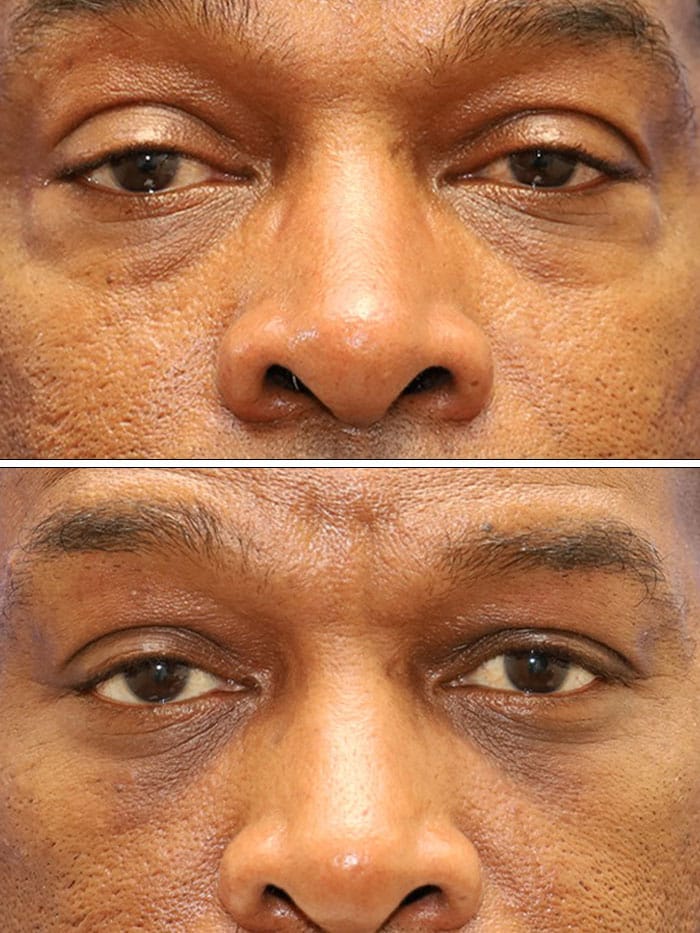
Nonsurgical
In younger patients (less than age 40), the tissues have typically not stretched so much that patients need surgery to get aesthetic improvement. In these cases, treatment with lower eyelid filler can hide early hollowness and smoothen the eyelid-cheek contours.
Surgical
In older patients, or younger patients with genetic eyelid bags, surgery can be the safest and best way at permanently treating the eyelid bags. A surgical plan is customized to each patient based on their skin type, skin quality, amount of eyelid and cheek fat, laxity and descent of tissues, recovery time, and facial structure. Options include scarless eyelid bag surgery in new Jersey, chemical peel or laser resurfacing, fat transfer from the abdomen, and adjunctive procedures including brow lifting, face and neck lifting, or facial implant placement.
What Is Recovery from Eyelid Surgery Like?
It’s natural for swelling and bruising to occur whenever incisions are made anywhere on the body. As such, all surgeries involve mild swelling and bruising around the incision sites for a few days, including eyelid surgeries. After the surgery, your eyelids will seem swollen and red for a few days, which you can minimize with cold compresses. During this period, you must sleep on your back with your head elevated.

Why Choose Dr. Ramesh?
Dr. Ramesh, MD, FACS, is an esteemed authority in eyelid bag surgery, offering tailored solutions for lower eyelid rejuvenation. Trained at UCLA’s prestigious Jules Stein Eye Institute, he employs advanced techniques to address excess skin, fat pads, and hollowing. With thousands of successful surgeries, Dr. Ramesh provides personalized care, ensuring natural-looking results and minimizing risks. Patients choose him for his expertise, dedication to safety, and compassionate approach, resulting in enhanced aesthetics and renewed self-confidence.

Expert in Eyelid Bag Surgery
8
3,000
5,000
What Is Dr. Ramesh's Experience?
Dr. Ramesh has performed thousands of eyelid surgeries and is one of the most experienced surgeons in the United States for this procedure. He has published multiple scientific publications on orbital decompression and is a highly sought-after national and international speaker on this topic.
Most importantly, Dr. Ramesh has refined and published his own modifications of the surgery that provide better results with a significantly reduced risk of complications. In this way, Dr. Ramesh’s advanced techniques allow for a more predictable and durable outcome after surgery.
Due to Dr. Ramesh’s wide range of surgical experience, you can also receive a combination of eyelid bag surgery in New Jersey, eyelid surgery, and a facelift or facial plastic surgery to attain all the facial cosmetic goals you have.
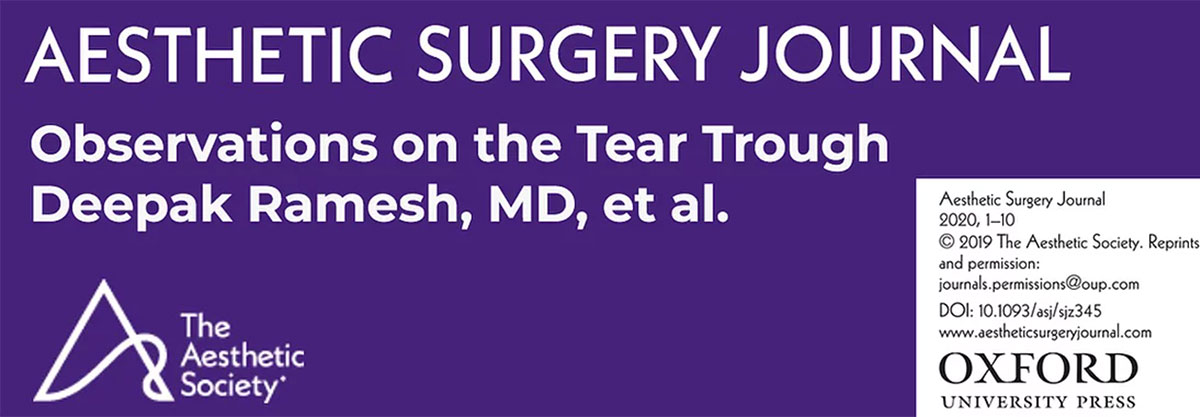
Revisional Eye Surgery
Revisional surgery can be challenging and needs an expert oculoplastic surgeon who is board-certified. Complications can cause vision loss and therefore require a surgeon with experience. What kind of revisions can be necessary?

Complications of Fat Grafting
Poorly performed fat grafting can cause lumps and bumps that require surgical removal and replacement with natural volume. Only very experienced blepharoplasty surgeons should attempt this as the poorly grafted fat can live inside the delicate muscle fibers that help your eyelid close. Shown is a patient who had lumps and bumps from poorly grafted fat that were removed and replaced by Dr. Ramesh with delicately placed microfat.
Complications of Filler
Filler can cause lumps, bumps, inflammatory edema, and lymphatic obstruction. Dr. Ramesh dissolved the filler and replaced it with autologous natural microfat for a much better result.


Complications of Skin Removal
Transcutaneous surgery is outdated and risks lid retraction. Too much skin removal or aggressive surgery can cause ectropion or lid retraction, pulling the skin away from the eyes etc etc. Dr. Ramesh performed multiple reconstructive surgeries to restore this man’s appearance and function.
Surgery in Young versus Older Patients
Are you too young for surgery? The decision depends on your anatomy, skin, and fat volumes, not your age. This patient was in her 20s and had surgery that would result in a lifetime of beautiful eyes.


Here is a patient in her 90s who also had surgery to improve her appearance, and she is delighted.
Older patients require treatment by a surgeon with thorough understanding and experience, and thousands of surgeries under his belt, to ensure a safe and long-lasting outcome.
Asian Eyelid Bag Surgery
This can be difficult because of different anatomy. Here is a young lady who had successfully customized Asian eyelid bag surgery.


Eyelid Bag Surgery in Skin of Color
With a deeper skin color, this surgery has to be specifically customized due to the propensity for scarring or keloid. Again, only experienced surgeons should be employed to do eye lid bag surgery. Here is a young patient in her 30s after Dr. Ramesh’s eyelid bag surgery.
What More Should I Know?

Is eyelid bag surgery permanent?
Eyelid bag surgery is permanent with long-lasting results. Patients do not typically need repeat surgery for bags, although they may experience skin changes with prolonged sun exposure. It is important to WEAR SUNSCREEN and a good moisturizer to maintain the results of surgery.
Can creams help with eyelid bags?
Eyelid creams cannot typically help eyelid bags when they reach a certain point. Surgical treatment usually offers the best and most predictable treatment. However, it is important to have a good skincare regimen (possibly including a retinol) to maintain results after surgery. These can be found in our skincare shop.
Can I combine droopy eyelid surgery with eyelid bag surgery?
Dr. Ramesh commonly performs upper eyelid and/or lower facial surgery in combination with eyelid bag surgery. You can learn more about upper eyelid surgery here.
What is an oculoplastic surgeon?
An oculoplastic surgeon is a facial plastic surgeon who has dedicated his/her career to focusing on the delicate interplay between the eye and the eyelids. An oculoplastic surgeon certified by the American Society of Ophthalmic Plastic and Reconstructive Surgery will have the most experience in providing safe, effective, and long-lasting results?
How long is surgery and recovery? Am I under general anesthesia?
Eyelid bag surgery in New Jersey usually lasts 60-90 minutes. Patients are under twilight anesthesia or light sedation, which minimizes risks. Patients are bruised and swollen for 7-10 days but are able to open their eyes and see. There are no patches or bandages over the eyes after surgery. While complete healing takes 2-3 months, your eyes will already be more open and refreshed after the initial week.
What are the risks of eyelid surgery?
All surgeries carry inherent risks, which is why your surgery must be performed by a highly-rated oculoplastic surgeon. The most common risks of eyelid bag surgeries include excessive bleeding, dry eye, infections, and asymmetry issues. However, Dr. Ramesh performs all eyelid surgeries under strict safety protocols and guidelines to minimize the risks.
Schedule an
Appointment
BOOK NOW
Contact Us
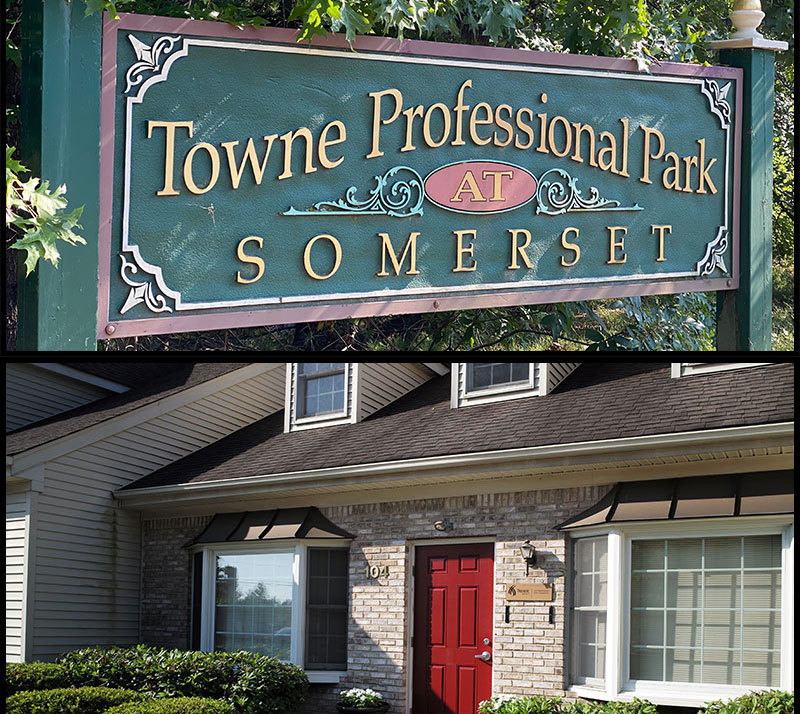
The Center for Eye and Facial Plastic Surgery
35 Clyde Road, #104
Somerset, NJ 08873
Monday – Friday: 8:30a – 4:30p
Livingston Office
22 Old Short Hills Rd Suite 202
Livingston, NJ 07039
Monday: 9:00a – 5:00p
Tuesday: 12:00p – 7:00p
Wednesday – Friday: 9:00a – 5:00p
P: (609) 608-0142
F: (855) 644-0469










